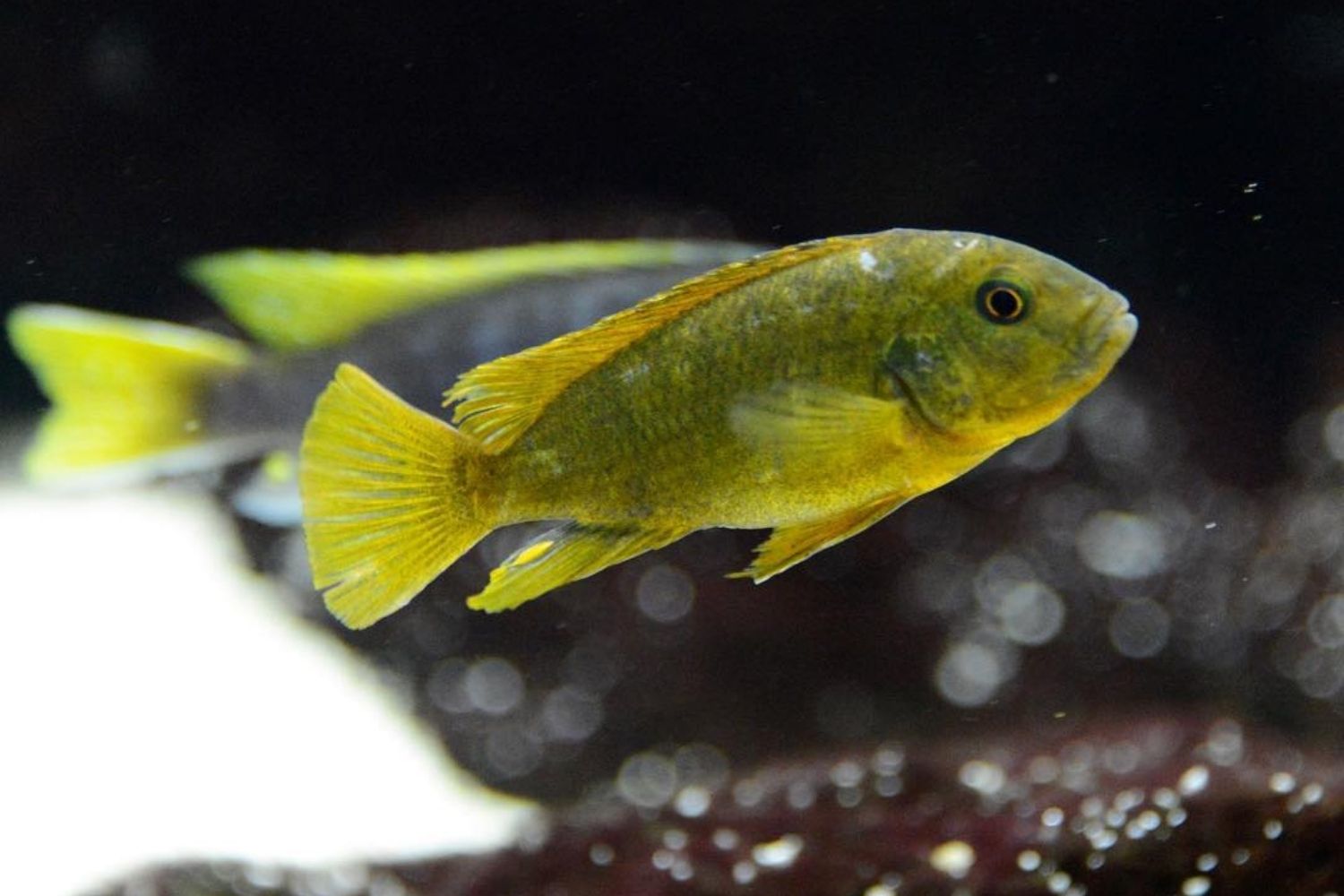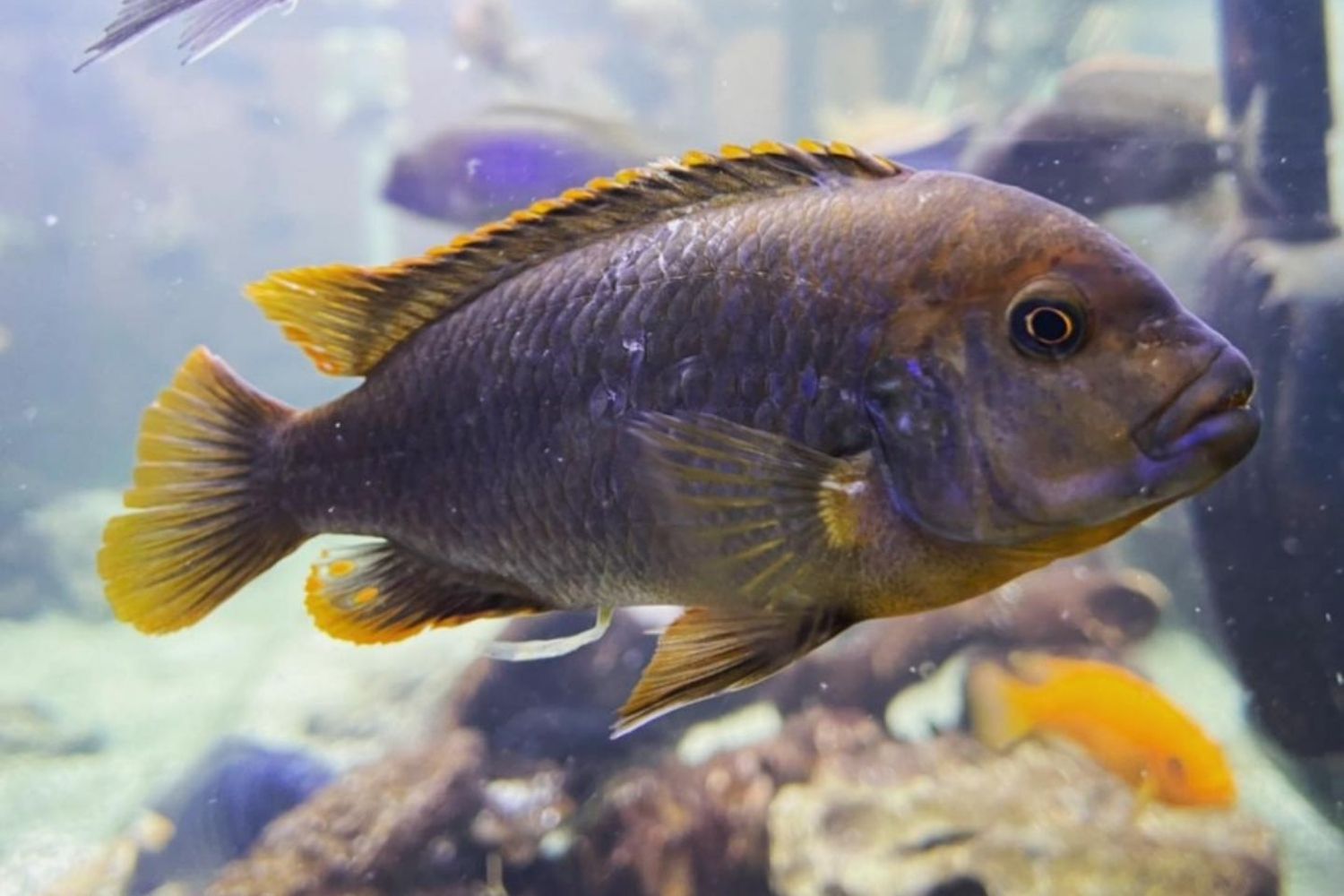Taking care of this cichlid may be easy and forgiving, but it is also a challenge if you do not know the basics of this fish. In this article, you will find all you need to know about Rusty Cichlid. We have made a lot of research about it. Therefore, we have a lot of experience with cichlids and we know for sure what they need and how they should be maintained.
Here you will find the complete care guide for this fish. By the end of the article, you’ll be confident enough to take care of it on your own. This fish will steal your heart with its intelligence. He is easily spoiled and can even feed on your hand if you provide him with a proper tank setup and a healthy life.
Overview
Rusty Cichlid is also known as Mbuna Lavender and is not as overly aggressive as other cichlids. This fish is amazing and has a special coloration, not as colorful as other cichlids such as Peacock cichlids, but yet unique with the rusty look. It is very special in coloration, shades of orange and red giving a rusty look, and bright blue to purple reflection.

Rusty Cichlid can be found in different colors. On our tank, we have it in yellow color.
When juvenile, this fish has orange shades on its body with a blue reflection. When it grows up and becomes an adult, this fish changes in color and becomes even more beautiful. Its body turns red, and the blue reflection turns purple up to the fins.
| Care Level | Intermediate |
| Temperament | Peaceful, mildly aggressive |
| Color | Orange, red, blue, and purple |
| Lifespan | 2-5 years |
| Size | 4 inches max 5.3 inches (10 cm max. 13 cm) |
| Diet | Omnivore |
| pH | 7.8 - 8.6 |
| GH | 7 - 9 dGH |
| Temperature | 78° - 82°F (25° - 27°C) |
| Minimum tank size | 10 gallon per fish (40 l) |
| Lightning | Medium |
Behavior
Rusty Cichlid is a peaceful fish compared with the overall aggressive Mbuna, although it is mildly aggressive when breeding. This fish also has amazing parental skills. They keep their eggs and fries in their mouth to protect them for a few weeks until they are able to swim freely.
They are quite shy and can be picked on and experience stress if sharing the tank with other larger, aggressive tankmates. This fish is also intelligent. Sometimes it may look like it’s begging for food and even willing to eat from your hand.
Size & Lifespan
This cichlid is quite small in size, about 4 inches, but it can reach a max of 5.3 inches if they grow healthy. This fish requires good maintenance, and if he meets the right conditions for healthy growth, he can live for about 3 to 5 years.
Origin & Habitat
Rusty Cichlid is an African Cichlid (Latin: Lodochromis Sprengerae) from Lake Malawi. This fish lives in alkaline waters, with a ph level of 8 or higher. The natural habitat of this fish is sandy and has rocks. The temperatures of the water in the wild are very high and usually live in littoral zones and rocky shorelines, windswept shallow water where the pH is high as well.
Diet: How to Feed Rusty Cichlid?
Rusty Cichlid is Omnivore, but it will accept foods with vegetable matter. This fish can be fed with both live and frozen food. But it can also be fed with dry food, pellets, and flakes. You should carefully balance their diet in order to grow them as healthy as possible. With that in mind, now it’s time to choose the best Cichlid food.
The best food for this fish would be a balanced diet of:
- Bloodworms
- Mosquito larvae
- Daphnia
- Pellets
- Good quality flake food
- Brine shrimp
- Vegetable matter (cucumber, blanched spinach, romaine lettuce)
Be careful with the feeding frequency. 1 to 2 times per day is great. As for the quantity, after you feed them, make sure to let them eat for 30 seconds up to 1 minute, and then immediately remove the excess food. You can also arrange one day per week for the adults to fast in order to prevent obesity. They will also tolerate 1 to 2 days without being fed.
Care & Tank Requirements
Taking care of Rusty Cichlid seems easy, but it can be quite challenging when it comes to the long-term care guide. There are some things that you should take more seriously in order to grow the fish happy and healthy. This fish loves vegetation, and a hardy planted tank would be the ideal choice. Plants such as Christmas Moss or Java Moss, and even Anubias would be a great choice since this fish tends to pick on delicate plants. In this case, you will avoid a mess in your tank.

Rusty Cichlid changes its colors as it grows.
The most important part for this fish is to prepare the proper water conditions. The rest is not that difficult. Sandy soil or small pebbles would be great for this fish, as it digs a little to create its own dwellings. Rocks would also be a great choice, or any branch for this fish, along with the plants mentioned above. Just make sure you leave enough space for the fish to swim freely.
Rusty Cichlid is a peaceful cichlid, but since he can be picked on, he needs places to hide in order to live happily and healthily. Some of the things that will help this fish to experience less stress when in a community, breed, or even play around, are:
- Inverted clay pots,
- Grottoes,
- Mangrove snags,
- Rocks,
- Hardy plants,
Adding these accessories to your tank will not only welcome the fish but also create an amazing design for your tank.
Tank Size
The tank size is also important for this fish. It is not very territorial, although it needs space when living with other fish. A freshwater aquarium of 80 liters or more is required for a pair of Rusty Cichlids. If you are planning to get more than a pair, consider choosing a larger fish tank and respect the ratio.
Water Parameters
Water parameters are very important for this fish, although, once you stabilize the aquarium, it is not difficult to maintain. Since this fish lives in hard and alkaline water in the wild, with high temperatures, it is important to maintain the range and create a similar environment to their natural habitat.
The temperature should be maintained around 78°-82°F, a 7.8 – 8.6 pH level, and a Water Hardness of 10–25 ° dGH. Sour water is not recommended as the fish can get sick in it. Filtration and aeration are also important when it comes to water parameters, with water changing every week to 25% of the total.
Diseases
Rusty Cichlids can experience various diseases as any other freshwater species, although there are some that should be mentioned that are also common diseases when talking about cichlids. Fungus and other parasites can cause various infections. In this case, if you see that your fish has a white around its mouth, it’s probably by the fungus. To treat this, you should deep clean your tank.
Ich is also a common disease. In this case, the fish will look sprinkled with salt and will try to scratch itself in the objects of the tank. To treat the Ich, you should gradually raise the temperature of the water up to 80 degrees F and keep it like that for like 3 days. You should also make sure to change the water by at least 50% and remove the carbon filters before you add the dose. This way, the medicine will not be removed.
Breeding
Rusty Cichlid is a freshwater fish that has been bred in captivity. They are Polygamous, which means you can breed several females with one male. It is very important to gradually raise the temperature and pH level in order to favor the breeding process.
A high protein diet is also recommended if you want to succeed since the new parent will eat the eggs if they are hungry. You wouldn’t want that to happen. The juveniles will be sexually mature in 14 weeks.

After a successful breeding, in a few months you will have some small Rusty Cichlid.
The male will do an amazing show to attract the females, and when they mate, they will make a small pit to use as a spawning ground. As soon as the female lays its eggs, the male will fertilize them. It will drop the eggs into the pit one by one. Meanwhile, the male will fertilize them.
After the fertilization process, the female will scoop the fertilized eggs into her mouth and continue the process until it is all done. On the other hand, the female tends to pick the caviar spots on the male’s fin, thinking they’re eggs, and the male will fertilize the rest of the eggs directly from its mouth. The number varies from 5 to 60 eggs.
The female, in this case, has amazing parental skills. Her ability to maintain the eggs for a few days in her mouth until they’re fried is amazing. It doesn’t eat until the whole procedure is finished and all the fries are ready to swim freely. They also feed the fries until they can be able to feed themselves.
Rusty Cichlid Female Vs Male
To sex, this fish is quite difficult but not something you can’t do. The females have rounded dorsal fins than the males. They are also smaller in size with a round belly. On the other hand, the males are larger and have sharper dorsal and anal fins. They also have caviar spots on the anal fins, which can clearly tell.

That's how a male Rusty Cichlid looks like.
Tank Mates
This amazing fish is very peaceful, and when talking about tankmates, you should consider protecting it from larger and more aggressive fish. It goes well with other Mbuna cichlids, but when in other fish communities, the perfect ratio would be 3 females and one male. This way, the female won’t breed with other species.
The best candidates for tankmates would be the:
- Peacock Cichlids
- Firemouth Cichlids
- Electric Blue Ram Cichlid
- Labidochromis Caerulus (Electric Yellow)
All of them are native to Lake Mawai and are ideal tankmates of Rusty Cichlid.
Conclusion: Should You Keep Rusty Cichlid in Your Tank?
Short answer, yes. Rusty Cichlid is an unusual cichlid when talking of its appearance, yet it is a charming cichlid that will win your heart with its rusty look and the blue to purple reflection. It is quite difficult to create the proper environment for this fish. It requires a little experience, although it is not something that a beginner can’t do. If you follow our care guide, it won’t be a big deal.

